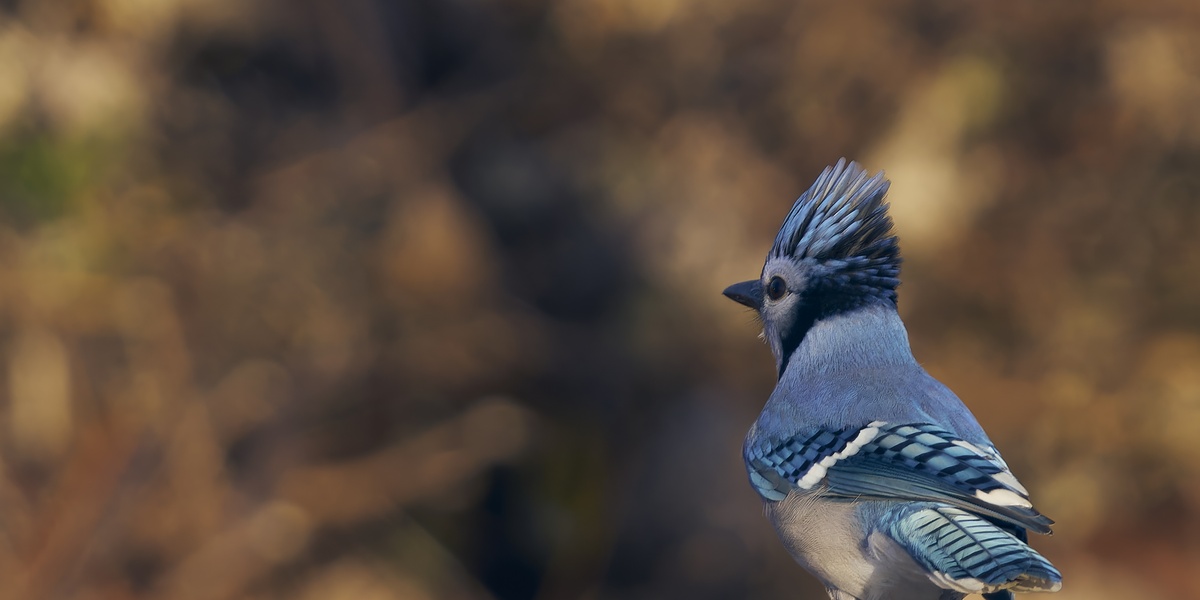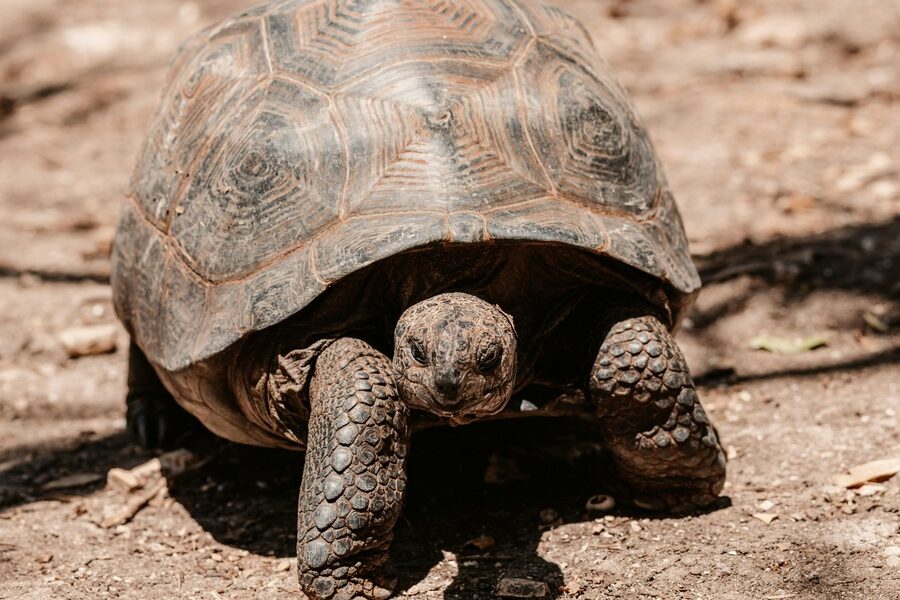Coastal shores, tropical forests and backyard ponds can surprise you with flashes of blue — a sudden color that makes even familiar walks feel new. Noticing these hues is a simple way to start learning about the species around you and the habitats they depend on.
There are 24 cute blue animals, ranging from Blue Crayfish to Superb Fairywren. For each species you’ll find below data organized as Scientific name,Size (cm),Range (where) so you can quickly compare identification details, size and where to look next — you’ll find below.
Where are the best places to spot these blue animals in the wild?
Look in the habitats tied to each species: freshwater creeks and leaf litter for crustaceans, woodlands and scrub for small birds like fairywrens, and coral reefs or mangroves for marine fish. Local nature reserves, early mornings and guided walks increase your chances; seasonal movements and breeding plumage also change how visible some species are.
What makes an animal appear blue rather than another color?
Blue often comes from structural coloration—microstructures that scatter light—or from specific pigments; birds like the Superb Fairywren get their blue from feather structure, while some crustaceans show pigment-based blues. The color can serve for signaling, camouflage in water or sky, or thermoregulation depending on the species.
Cute Blue Animals
| Name | Scientific name | Size (cm) | Range (where) |
|---|---|---|---|
| Blue Jay | Cyanocitta cristata | 22-30 | Eastern and central North America in forests and suburban yards. |
| Eastern Bluebird | Sialia sialis | 16-21 | Eastern North America in open woodlands, farmlands, and orchards. |
| Mountain Bluebird | Sialia currucoides | 16-20 | Western North America in open country and high-altitude meadows. |
| Indigo Bunting | Passerina cyanea | 11-13 | Eastern North America in brushy fields and woodland edges. |
| Hyacinth Macaw | Anodorhynchus hyacinthinus | 100 | Central and eastern South America in savannahs and woodlands. |
| Blue-and-Yellow Macaw | Ara ararauna | 76-86 | South American forests and woodlands, especially near waterways. |
| Superb Fairywren | Malurus cyaneus | 14 | Southeastern Australia in forests, scrublands, and suburban gardens. |
| Indian Peafowl | Pavo cristatus | 100-230 | Indian subcontinent, now introduced worldwide in parks and estates. |
| Little Blue Penguin | Eudyptula minor | 30-33 | Coastlines of southern Australia and New Zealand. |
| Blue Poison Dart Frog | Dendrobates tinctorius “azureus” | 3-4.5 | Suriname, in isolated forest patches near streams. |
| Electric Blue Day Gecko | Lygodactylus williamsi | 6-9 | A tiny 8 sq km area of the Kimboza Forest in Tanzania. |
| Blue-tailed Skink | Plestiodon fasciatus | 12-21 | Eastern North America in moist woodlands and garden edges. |
| Blue-tongued Skink | Tiliqua scincoides | 45-60 | Australia in a wide variety of habitats from forests to deserts. |
| Blue Tang | Paracanthurus hepatus | 20-30 | Indo-Pacific coral reefs. |
| Blue Damselfish | Chrysiptera cyanea | 5-8 | Western Pacific Ocean on coral and rubble reefs. |
| Siamese Fighting Fish | Betta splendens | 6-8 | Shallow freshwater habitats of Southeast Asia. |
| Blue Morpho Butterfly | Morpho peleides | 12-20 | Rainforests of Mexico, Central America, and South America. |
| Common Blue Butterfly | Polyommatus icarus | 2.8-3.6 | Europe, North Africa, and temperate Asia in grassy habitats. |
| Emperor Dragonfly | Anax imperator | 7-8 | Across Europe, Africa, and Asia near still or slow-flowing freshwater. |
| Blue Orchard Bee | Osmia lignaria | 1-1.5 | North America in woodlands and orchards. |
| Blue Sea Slug | Glaucus atlanticus | 3-4 | Floats on the surface of temperate and tropical oceans worldwide. |
| Blue-ringed Octopus | Hapalochlaena lunulata | 12-20 | Shallow reefs and tide pools in the Pacific and Indian Oceans. |
| Blue Starfish | Linckia laevigata | 20-30 | Tropical waters of the Indian and Pacific Oceans on reef flats. |
| Blue Crayfish | Procambarus alleni | 10-15 | Freshwater habitats in Florida, USA. |
Images and Descriptions

Blue Jay
Known for its intelligence and noisy calls, the Blue Jay’s vibrant color is structural. Microscopic particles in its feathers scatter light, making them appear blue to our eyes. Despite their sometimes-aggressive behavior, their crest and bright plumage make them a backyard favorite.
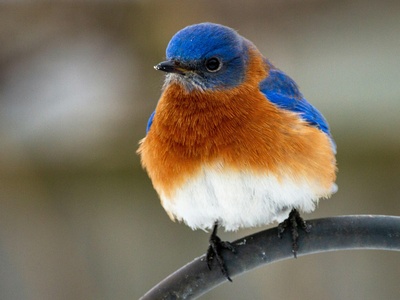
Eastern Bluebird
This cheerful bird is a sign of spring. The male’s brilliant blue back and head are a structural color, caused by light scattering through its feather structure. They are cavity nesters and readily use man-made birdhouses, bringing their beautiful color into our gardens.
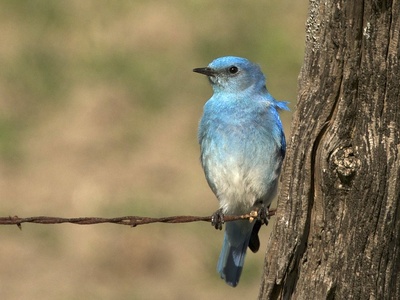
Mountain Bluebird
The male Mountain Bluebird is a breathtaking sky-blue all over. This stunning coloration is not from pigment but from the structure of its feathers refracting light. Unlike other bluebirds, it can hover in mid-air while hunting for insects on the ground.
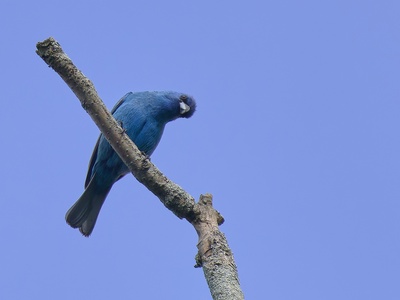
Indigo Bunting
The male Indigo Bunting is a spectacular, vibrant blue during breeding season. This is a structural color; the feathers absorb other colors and reflect blue light. Interestingly, these small songbirds migrate at night, using the stars for navigation.
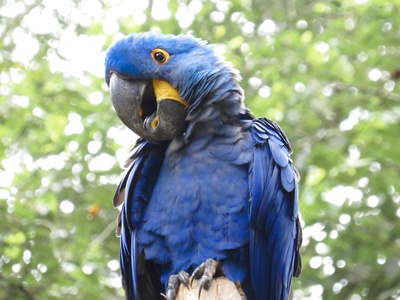
Hyacinth Macaw
The largest flying parrot species, its stunning cobalt-blue feathers get their color from true pigments called psittacofulvins, unique to parrots. Known as “gentle giants,” they have incredibly powerful beaks capable of cracking hard nuts and seeds.
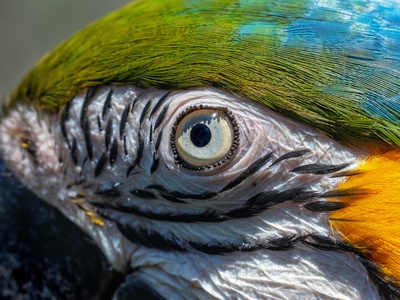
Blue-and-Yellow Macaw
This intelligent and social parrot has a brilliant blue back and wings contrasting with a bright yellow chest. Its blue is a combination of pigment and structural coloration. They are known to mate for life, often seen flying in large, affectionate pairs.
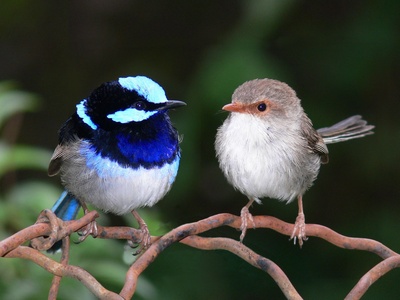
Superb Fairywren
The tiny breeding male is stunning, with a vibrant sky-blue cap and back. This iridescent color is structural, designed to catch the light and attract a mate. These birds are highly social and live in cooperative groups that help raise chicks.
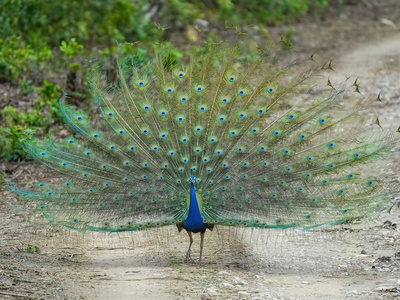
Indian Peafowl
The male, or peacock, is famed for its iridescent blue neck and massive decorative train. The blue is a structural color created by crystalline structures in the feathers. This display isn’t just for show; it’s a key part of the male’s elaborate courtship ritual.

Little Blue Penguin
The smallest of all penguins, this adorable bird is also called a fairy penguin. Its slate-blue or indigo feathers get their color from pigments and provide excellent camouflage in the water. They spend their days hunting at sea and return to their burrows ashore at dusk.
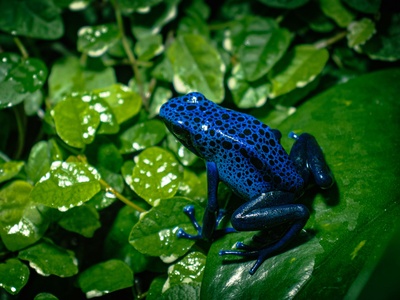
Blue Poison Dart Frog
This stunning frog’s brilliant blue skin warns predators of its toxicity. The color comes from pigments in its skin cells. Each frog has a unique pattern of black spots, much like a human fingerprint, making every individual identifiable.
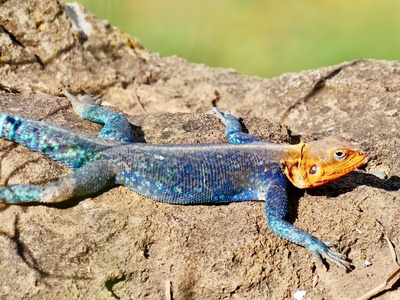
Electric Blue Day Gecko
This critically endangered gecko displays stunning sexual dimorphism; males are a brilliant electric blue while females are greenish-brown. The male’s vibrant color, derived from skin pigments, is used to attract mates and defend territory. They are active during the day, hunting for small insects.
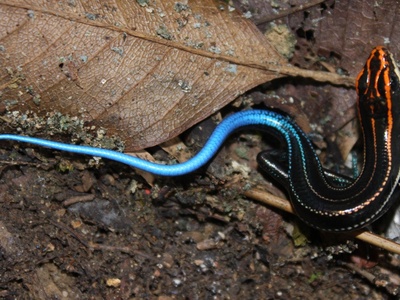
Blue-tailed Skink
While the adults are brownish, the juveniles are famous for their metallic, electric-blue tails. This bright tail, colored by pigments, is designed to distract predators. It can break off if attacked, allowing the young skink to escape while the predator is left with a wiggling tail.
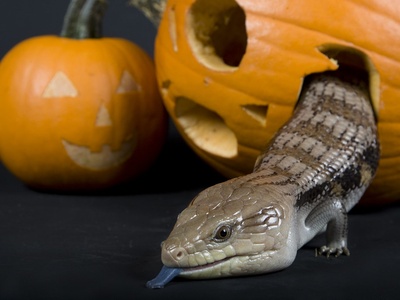
Blue-tongued Skink
This lizard is not blue, but it possesses a shockingly bright, cobalt-blue tongue. When threatened, it opens its mouth wide and sticks out its tongue as a startling bluff. The unexpected flash of pigmented color is often enough to scare away potential predators.
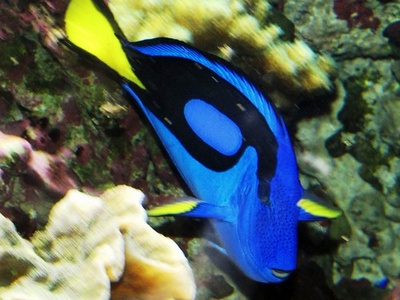
Blue Tang
Made famous as “Dory,” this fish has a vibrant royal blue body colored by pigmented cells called chromatophores. It can even adjust the intensity of its color based on mood. A sharp spine at the base of its tail provides a surprisingly effective defense mechanism.
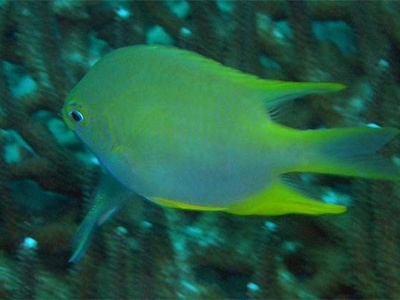
Blue Damselfish
This small, electric-blue fish is a jewel of the coral reef. Its brilliant color comes from pigment and is used for species recognition and communication. Males are territorial and will perform a fluttering “dance” to attract females to their nesting site.
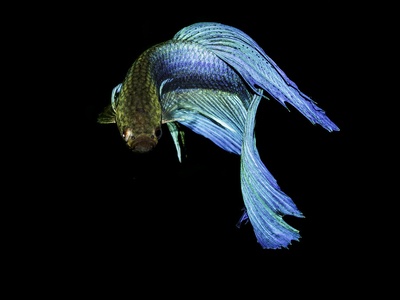
Siamese Fighting Fish
While wild bettas are duller, domestic varieties are bred for their stunning colors, including brilliant blues. Their coloration comes from layers of pigmented cells. Known for their flowing fins and aggression, males build bubble nests at the water’s surface to incubate eggs.

Blue Morpho Butterfly
The iridescent blue of this butterfly is one of nature’s wonders. It’s not pigment but structural color; microscopic scales on the wings reflect blue light. The flashing color as it flies against the dull brown underside helps it evade predators.

Common Blue Butterfly
This delicate butterfly brings a splash of color to meadows. The male has violet-blue upper wings, a structural color that flashes in the sun. The less-vibrant female is mostly brown but often has a dusting of blue scales near her body.
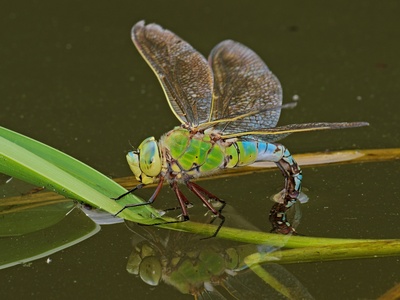
Emperor Dragonfly
The male Emperor Dragonfly has a striking sky-blue abdomen, making it highly visible as it patrols its territory. This color is pigment-based and helps it stand out to rivals and potential mates. It is one of the largest and fastest dragonflies in its range.
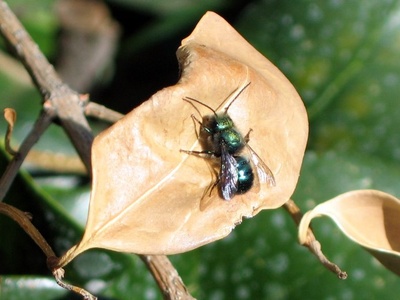
Blue Orchard Bee
This gentle, solitary bee is a metallic, dark blue. The color comes from structural properties in its exoskeleton that refract light. It’s an incredibly efficient pollinator, especially for fruit trees, and is often called the “mason bee” for the mud walls it builds in its nest.

Blue Sea Slug
Also called the “blue dragon,” this tiny nudibranch is a beautiful predator. Its blue and silver coloration, from pigments, provides camouflage against the ocean’s surface. It feeds on venomous siphonophores like the Portuguese man o’ war, storing their stinging cells for its own defense.
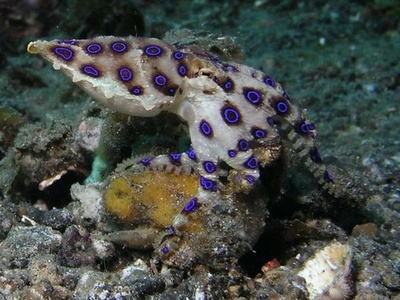
Blue-ringed Octopus
This tiny octopus is cute but deadly. Its docile, sandy color can erupt in a flash of iridescent blue rings when threatened. These pigmented rings are a dramatic warning of its potent venom, for which there is no antivenom. It is one of the most venomous marine animals.

Blue Starfish
This starfish is a brilliant, uniform blue, though it can also be aqua, purple, or orange. Its vibrant color is from a pigment called linckiacyanin. It has the amazing ability to regenerate its entire body from a single severed arm.

Blue Crayfish
While many are brownish, a naturally occurring variant of this species is a stunning electric blue. This is a genetic trait, not an artificial color. These hardy crayfish are popular in the aquarium trade for their brilliant and unusual appearance.
